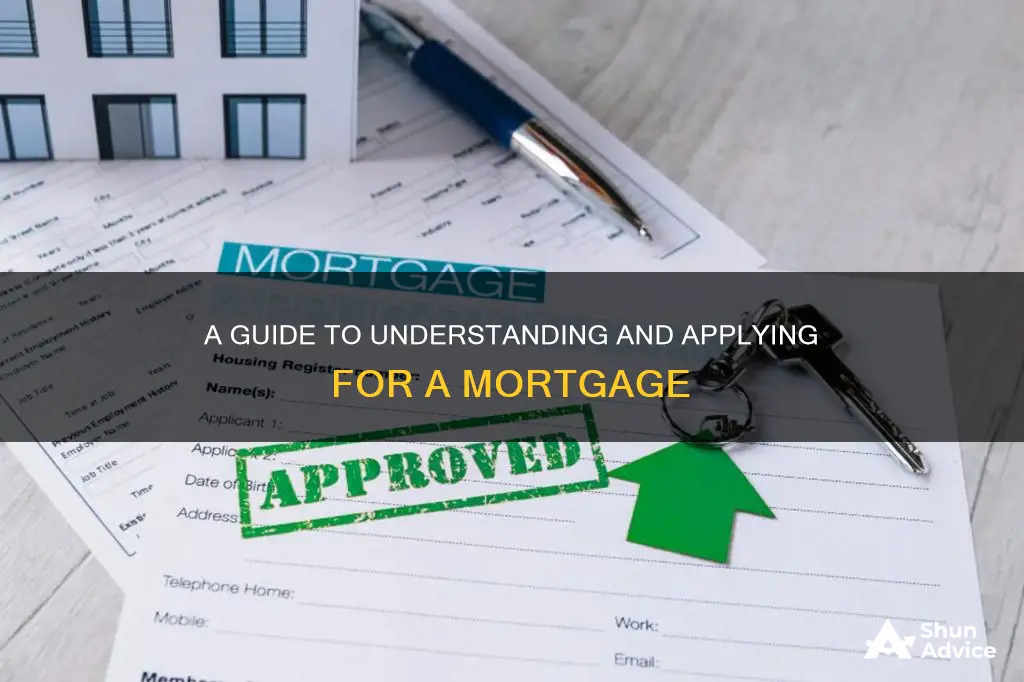
Getting a mortgage can be a daunting process. It involves several steps, from getting pre-approval from a mortgage lender to closing the deal. Before applying for a mortgage, it is essential to research and compare different lenders to find the best rates and options that suit your needs. You should also assess your financial situation, including your credit score, income, debt-to-income ratio, and ability to make a down payment. Once you have secured pre-approval, you can start searching for properties within your budget and work with a real estate agent to submit an offer. The mortgage application process then begins, followed by loan processing, underwriting, and finally, closing the deal.
What You'll Learn

How to improve your credit score for a mortgage
A higher credit score means a better chance of approval for a mortgage and a lower interest rate. Your credit score is one of the primary factors that mortgage lenders consider when reviewing your loan application. Lenders want to ensure that you will repay the owed amount, and your credit score is one factor they look at to determine your risk level.
- Check your credit score and credit reports: Reviewing your credit reports and credit scores helps you familiarise yourself with your credit history and identify areas that need attention, such as high-balance credit cards, past-due accounts, and inaccurate information. You can check your credit score and reports from the three main credit bureaus: Experian, Equifax, and TransUnion.
- Make all payments on time: Your payment history is the most influential factor in your credit score, and late payments can stay on your report for up to seven years, making it more difficult to get approved for a mortgage. Set up automatic payments to avoid missing any due dates.
- Reduce your credit card balances: Keep your credit card balances and the number of accounts low. Your credit utilisation ratio, or the amount you owe against your total available credit, accounts for 30% of your score. If your utilisation ratio is over 30%, work on paying down those balances to improve your ratio.
- Avoid opening new credit accounts: Applying for new credit can negatively impact your credit score and increase your debt-to-income ratio (DTI), making it challenging to get approved for favourable loan terms. Mortgage lenders typically prefer to see no new credit accounts or inquiries on your credit reports in the six to 12 months before your application.
- Become an authorised user: If you're a first-time buyer with a limited credit history, you can become an authorised user on a parent's or relative's credit card. By doing so, you can benefit from their positive payment history, which can help improve your credit score.
- Seek credit counselling: If you're struggling with significant debt, consider credit counselling services offered by nonprofit organisations. These services can provide you with professional advice on managing your debt and improving your creditworthiness.
Remember, improving your credit score is just one aspect of preparing for a mortgage application. It's also essential to consider your income, savings, and overall financial health to ensure you can afford the loan payments and meet the lender's requirements.
Making Mortgage Payments: Wells Fargo Guide
You may want to see also

The different types of mortgages
There are several types of mortgages available, each with its own benefits and features. Here are the main types of mortgages:
Conventional Mortgages
These are mortgages offered by private banks and are the most common type. They typically have higher minimum credit score requirements than other loan types (usually a minimum of 620) and are harder to qualify for than government-backed mortgages. Conventional mortgages can be further divided into conforming and non-conforming loans. Conforming loans meet a set of Federal Housing Finance Agency (FHFA) standards, including credit, debt, and loan size guidelines. They can be purchased by government-sponsored enterprises like Fannie Mae and Freddie Mac. Non-conforming loans, on the other hand, do not meet these standards and are considered riskier for lenders. One common type of non-conforming loan is a jumbo loan, which exceeds the conforming loan limit.
Jumbo Loans
Jumbo loans are designed for borrowers with good credit scores who are looking to buy more expensive homes. These loans exceed the conforming loan limits and often require a large down payment, typically of at least 20%. Jumbo loans do not conform to the guidelines set by Fannie Mae and Freddie Mac, and they may allow you to borrow over $1 million.
Government-Backed Loans
These loans are insured by government agencies such as the Federal Housing Administration (FHA), Veterans Affairs (VA), or the United States Department of Agriculture (USDA). Government-backed loans offer more flexibility in qualification criteria and may provide savings on interest or down payment requirements. For example, FHA loans are available to borrowers with lower credit scores and limited down payment funds, while VA loans offer lower interest rates and can be obtained with no down payment for those who have served in the military. USDA loans are for low-income borrowers purchasing homes in qualified suburban or rural areas and also have lower mortgage insurance requirements.
Fixed-Rate Mortgages
Fixed-rate mortgages offer stability and predictability in your monthly payments. The interest rate and principal/interest payment remain the same throughout the loan term, making it easier to budget for housing costs. Common fixed-rate options include 15- and 30-year mortgages.
Adjustable-Rate Mortgages (ARMs)
ARMs, in contrast, have variable interest rates that fluctuate over the repayment term. They often start with a lower introductory rate, making them attractive for those purchasing a starter home or who don't plan to stay in the property for the full loan term. However, it can be challenging to predict your financial standing with an ARM due to potential rate adjustments. A popular option is the 5/1 ARM, which has a fixed rate for the first five years, followed by annual adjustments.
Making Woolwich Mortgage Overpayments: A Step-by-Step Guide
You may want to see also

How to apply for a mortgage
Applying for a mortgage can be a daunting process, but with some preparation, you can be well on your way to becoming a homeowner. Here are the steps you can take to apply for a mortgage:
Step 1: Preparation
Before you start looking for a mortgage, it is important to do your research and understand the different types of mortgages available. Familiarize yourself with the application process, and review your credit report from credit bureaus such as Experian, Equifax, and TransUnion. A higher credit score increases your chances of mortgage approval and more favourable rate offers.
Step 2: Shop for a Mortgage
Explore different lenders and compare their interest rates, fees, and loan terms. Consider the type of interest rate (fixed or adjustable) and the specific requirements of each mortgage option. By shopping around, you can find the best deal that suits your needs.
Step 3: Prequalification and Preapproval
Some lenders offer prequalification, which gives you an idea of the amount they are willing to lend based on estimated financial information. Preapproval, on the other hand, is a more formal process where the lender commits to loaning you a specified amount, subject to certain conditions. Preapproval can save you time when you're ready to make an offer on a house.
Step 4: Choose a Lender and Complete the Application
Select a lender that suits your needs and meets your financial situation. You can apply for a mortgage in person, by phone, or online. Provide all the required documentation, such as identification, income verification, tax returns, bank statements, and investment account statements. Be sure to disclose all relevant financial information to avoid delays in the approval process.
Step 5: Lock in Your Rate (Optional)
If you want to protect yourself from rising interest rates, you can choose to lock in your rate with your lender. This guarantees the interest rate until the lock expiration date. However, if you anticipate interest rates decreasing in the future, you may opt to wait before locking in your rate.
Remember to take your time, carefully review all the options, and seek out the mortgage that works best for your current and future needs.
Mortgage Freedom: Marking Your Loan as Paid Off
You may want to see also

How to get pre-approval for a mortgage
Getting pre-approved for a mortgage is an important step in the home-buying process. It lets sellers know that you are a serious buyer and can help you stand out in a competitive market. Here is a step-by-step guide on how to get pre-approved for a mortgage:
Step 1: Understand the Difference Between Prequalification and Preapproval
Prequalification is an early step in the home-buying journey. It is a quick and simple process that can often be done online and provides an estimate of how much you could borrow based on self-reported financial information. Preapproval, on the other hand, is a more in-depth process that requires more documentation and verification of your finances and creditworthiness. A preapproval letter from a lender indicates that they are tentatively willing to lend you a specific amount, but it is not a guaranteed offer.
Step 2: Gather the Required Documentation
To get pre-approved for a mortgage, you will need to provide detailed information about your finances, including employment, income, debt, and financial accounts. This may include documents such as bank statements, pay stubs, tax returns, W-2 forms, and information about your assets and debts.
Step 3: Contact a Lender
Speak with a lender to initiate the pre-approval process. You can find a lender through online platforms, such as Zillow or Rocket Mortgage, or by contacting financial institutions directly. Different lenders may have different requirements and processes, so it is important to ask questions and understand what is needed for pre-approval.
Step 4: Provide the Necessary Information and Documentation
Submit the required information and documentation to the lender for review. This may include completing a mortgage application and authorizing the lender to perform a credit check. The lender will use this information to determine your creditworthiness and calculate the loan amount, interest rate, and monthly payment you could qualify for.
Step 5: Receive the Preapproval Decision
After reviewing your information, the lender will provide you with a preapproval decision. If pre-approved, you will receive a preapproval letter, which is typically valid for a limited period (often 60 to 90 days). This letter can be presented to sellers when making an offer on a home.
Step 6: Address Any Issues or Concerns
If your preapproval request is denied or you have concerns about your credit score or financial situation, don't hesitate to address them. You can request a copy of your credit score from the lender and work on improving your credit if necessary. You may also consider comparing multiple lenders to find the most favourable terms and interest rates.
Making Overpayments on Your Barclays Mortgage: A Guide
You may want to see also

How to compare mortgages
When it comes to comparing mortgages, there are several factors to consider. Firstly, determine the type of mortgage that suits your financial situation. Research and compare interest rates, discount points, and closing costs. You can use online tools and calculators to compare rates for different loan options.
It is important to assess your financial situation and what you can afford. Calculate your debt-to-income (DTI) ratio by summing up your monthly debt payments and dividing that figure by your gross monthly income. A lower DTI ratio gives you more flexibility in your budget. You can also use online calculators to determine how much house you can afford, factoring in your income, expenses, and down payment.
Once you have a specific home in mind, you can start comparing loan offers from multiple lenders. Request and review Loan Estimates, which provide important details about the loan, allowing you to compare rates and fees. You can also compare the soft skills of lenders, such as their communication and reliability.
Before approaching lenders, gather documents that show your income, investments, and debt. These include payslips, tax returns, bank statements, and proof of deposit. You may also need to provide information on your outgoings, credit card balances, and other loans. Having these documents ready will streamline the mortgage application process.
You can also consider contacting a mortgage broker or adviser, who can help you secure a great deal and explain all the associated charges and fees. They may charge a fee for their services, so be sure to discuss this with them upfront.
Making Mortgage Overpayments: A Guide to Getting Started
You may want to see also
Frequently asked questions
A mortgage is a loan provided by a financial institution, such as a bank, to buy a home. The lender reviews your finances and credit history to confirm that you can afford the loan payments.
The first step is to get pre-approval from a mortgage lender. You will need to provide information about your income, assets, and credit score. Once you are pre-approved, you can start looking for properties. When you find a suitable property, you will need to put in an offer and begin the mortgage application process.
You will need to provide personal information, such as your Social Security number and ID, income verification, such as pay stubs or tax returns, bank statements, and proof of other debts and assets. You will also need to provide details of the property you want to buy, including the address, the estate agent, and your solicitor.
Having a strong credit history and credit score is important. Lenders will also look at your income and job history, debt-to-income ratio, and the type of property you want to purchase. Improving your credit score, saving for a larger down payment, and knowing what you can realistically afford will all improve your chances of getting a mortgage.
Once your loan is approved, you will receive a document called a Closing Disclosure, which outlines the terms of your loan, including your monthly mortgage payment, down payment, interest rate, and closing costs. You will then attend a closing meeting, where you will have the chance to ask any last-minute questions and finalise the loan.







